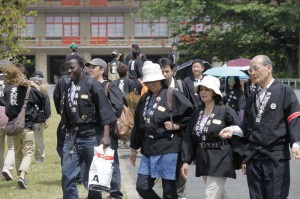 The 37th English class of Shuyoka (the three-month Spiritual Development Course) began on April 1 as part of the 840th session of Shuyoka with the participation of 19 followers from various countries and regions including Australia, Kenya, Myanmar, Nepal, Thailand, the Philippines, and the U.S. This year, marking the 70th year since Shuyoka was launched, the Chinese class and the first Nepali class started at the same time. The instructors for this yearʼs English class are Rev. Michael Yuge from New York, who serves as the homeroom instructor and teaches the classes on The Doctrine of Tenrikyo and the service dance, and Rev. Hamilton Niwa from San Francisco, who teaches the classes on The Life of Oyasama and the Mikagura-uta, The Songs for the Service.
The 37th English class of Shuyoka (the three-month Spiritual Development Course) began on April 1 as part of the 840th session of Shuyoka with the participation of 19 followers from various countries and regions including Australia, Kenya, Myanmar, Nepal, Thailand, the Philippines, and the U.S. This year, marking the 70th year since Shuyoka was launched, the Chinese class and the first Nepali class started at the same time. The instructors for this yearʼs English class are Rev. Michael Yuge from New York, who serves as the homeroom instructor and teaches the classes on The Doctrine of Tenrikyo and the service dance, and Rev. Hamilton Niwa from San Francisco, who teaches the classes on The Life of Oyasama and the Mikagura-uta, The Songs for the Service.
Prior to the start of Shuyoka, the Overseas Department conducted a weeklong preliminary training session at Moya 132, aiming to help the English class students get used to life in the Home of the Parent by providing them with an opportunity to study and stay together so that they could make an easier transition to life in their respective followers dormitories.
The daily schedule of Shuyoka is basically the same for all students whether in the English class or in a Japanese class. Their day starts with the morning service at the Main Sanctuary. After a training session back in their dormitories, they depart for Shuyoka. In the mornings, they attend classes on The Doctrine of Tenrikyo, The Life of Oyasama, and the service dance. In the afternoons, students practice the musical instruments for the service and engage in hinokishin at various sites around the Home of the Parent. After returning to their dormitories, they engage in cleaning hinokishin, attend the evening service, and participate in training sessions.
In addition, they are periodically assigned to clean the Worship Halls and Corridor in the morning or afternoon. The morning cleaning starts an hour before the morning service, thus making it necessary for them to rise very early. Attending the Besseki lectures—three each month—is also an important part of Shuyoka life for students who have yet to receive the truth of the Sazuke.
A Close-up of the Students
Ms. Jennifer Holthaus, 38, from Hawaii, came to Jiba with her two-year-old son, Ayden. Although her mother in Hawaii was concerned that the aftermath of the March 11 earthquake and tsunami as well as the nuclear power plant crisis might have an adverse effect on his mental and physical health, Jennifer decided to enroll in Shuyoka as she had planned, in the hope of “sowing seeds of sincerity in Jiba for three months in order to have negative causalities canceled.”
 Since arriving in the Home of the Parent, she has written to her mother a number of times about how her mind has changed in the course of the spiritual training and how Ayden has grown.
Since arriving in the Home of the Parent, she has written to her mother a number of times about how her mind has changed in the course of the spiritual training and how Ayden has grown.
“Studying The Life of Oyasama has inspired me to become a woman like Oyasama, who had a compassionate heart,” Mrs. Holthaus said, adding: “Ayden, who was crying all the time in the beginning, now smiles while singing the Mikagura-uta with me. I want to have a kind and humble heart so that I can become the foundation of my family.”
Mr. Ryo Glenn Wong is a 22-year-old Yoboku from California. Last January, he visited his grandfather in a hospital in Kyoto Prefecture. As he listened to his grandparents talking about their single-hearted devotion to the faith, he could tell they wanted him “to learn more about the teachings and have a strong faith.”
After returning home, he made up his mind to attend Shuyoka. “I wanted to make my grandfather happy,” said Mr. Wong. Half a month into Shuyoka, however, he had to face his grandfatherʼs passing away for rebirth. He was so shocked that he thought about withdrawing from Shuyoka. But seeing his grandfather looking so peaceful, he fell into tears because he felt as if his grandfather was encouraging him by saying: “I will watch over you. Keep going!”
“I will follow the path with all my heart.” Mr. Wong renewed his pledge before his deceased grandfather. “I want to internalize everything I can learn during Shuyoka and put all my heart into listening to lectures and doing every activity including hinokishin.” He now attends Shuyoka in higher spirits than ever before.




